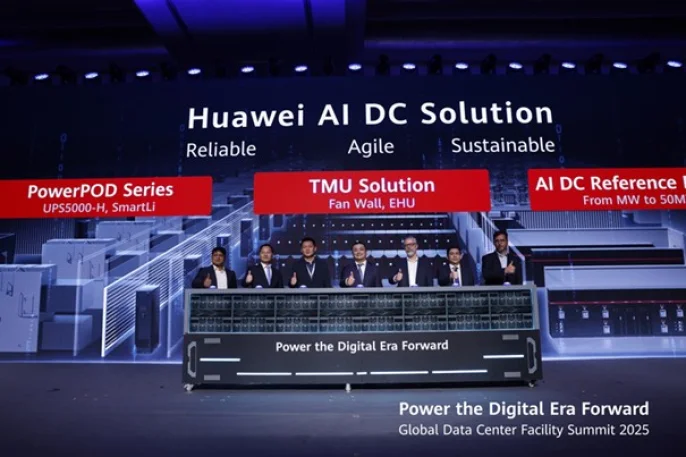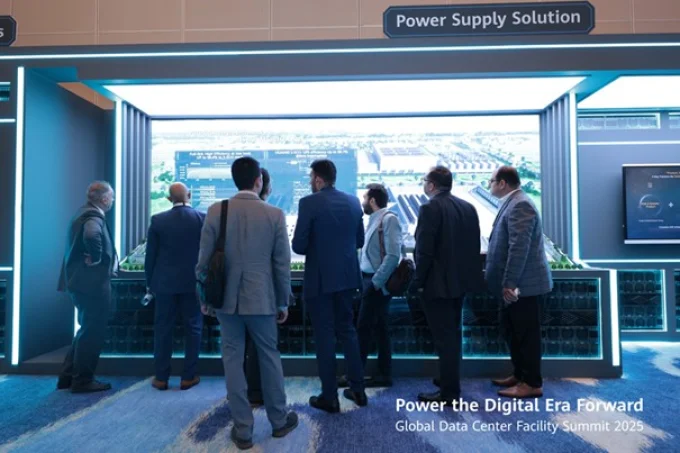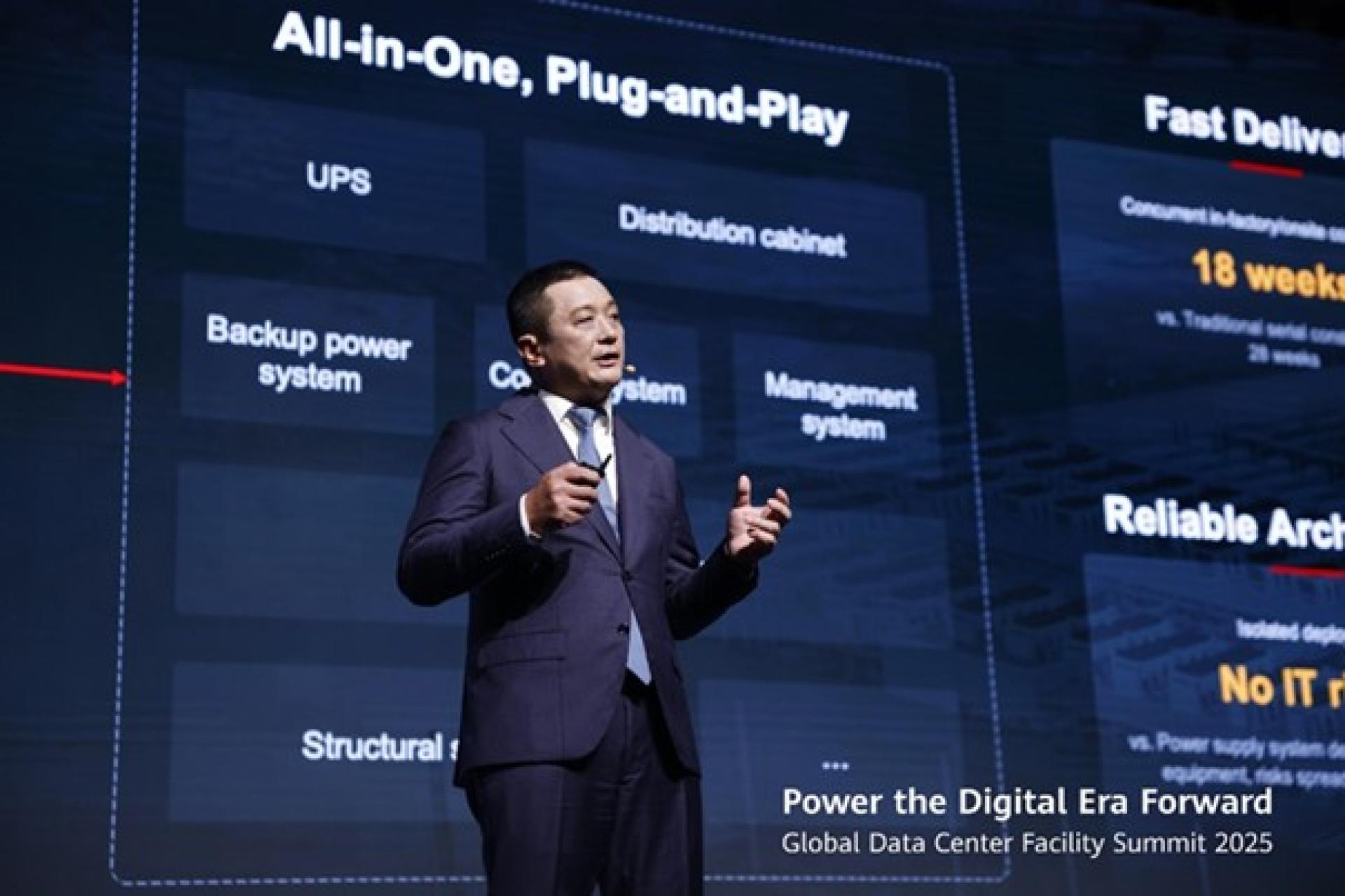On 13 May 2025, the Global Data Centre Facility Summit 2025 with the theme ‘Power the Digital Era Forward’ was held in Dubai. This summit brought together more than 500 intelligent computing industry leaders, technical experts and ecosystem partners to discuss new growth opportunities and development paths for the data centre (DC) industry in the intelligent computing era and released the AI DC solution, accelerating the industry into a new era of intelligent computing
Embracing the golden age of intelligent computing for a win-win future
Charles Yang, Senior Vice President of Huawei and President of Global Marketing, Sales and Services Huawei Digital Power, said in his opening speech that the golden age of computing infrastructure has arrived, as AI models benefit various industries and enterprises improve their competitiveness by deploying local AI inference computing platforms. It is estimated that global AI DC capacity will exceed 100 GW by 2028, generating a market space of over USD 600 billion in the energy infrastructure sector alone.
According to Charles, higher reliability, faster deployment and higher energy demand have become the three biggest challenges for AI DC development. And Huawei believes there are three major development trends of AI DCs in the future:
- Improve AI DC reliability through architecture innovation: Reliability is a top priority. A power system with an isolated architecture, such as a dedicated prefabricated container or remote implementation, can significantly improve system reliability and ensure stable DC operation.
- Accelerate AI DC construction through modular and prefabricated architecture: Huawei's PowerPOD uses a fully decoupled architecture to achieve one power system per container. It significantly shortens time-to-market (TTM), achieves a prefabrication rate of over 90% and reduces on-site manpower by 70%.
- Improve energy efficiency of AI DC through green power deployment and efficiency optimisation: Green power sources can be provided by direct green power supply and PV development on campuses. The energy efficiency of existing DCs can be improved by AI-based energy efficiency optimisation.
Building a robust foundation for the era of intelligent computing
Building a robust foundation for the era of intelligent computing
During the summit, Bob He, Vice President of Huawei Digital Power and President of Data Centre Facility & Critical Power Product Line, Huawei Digital Power, delivered a keynote speech titled ‘Building a Robust Foundation for the Intelligent Computing Era’, and released Huawei's AI DC solution globally, leading the industry into the era of intelligent computing.
The AI industry is thriving in the era of intelligent computing at an unprecedented pace. While intelligent computing centres face strong growth in construction, they also face challenges such as reliability, rapid delivery, elastic deployment and low total cost of operation (TCO). In response, Huawei proposed first core principles for AI DC constructions.
- Reliable: Reliability is a top priority. The reliability of AI DCs throughout their lifecycle must be ensured in terms of products, architecture, intelligent management and professional services. Take Huawei's lithium batteries as an example. In terms of product, an E2E security defence line has been established at cell, packet, device and system levels. At architecture level, an isolated architecture is used to minimise the impact of accidents on services. At the system level, cloud-based proactive prevention and on-site inspection are combined to detect failures early and ensure system security.
- Agile: AI-DCs should be adaptable from components to system to flexibly handle uncertainties in AI services. Huawei's PowerPOD uses a fully decoupled architecture and integrates subsystems such as UPS'en and lithium batteries. The solution realises one power system per container and is deployed outdoors, meeting the requirements of on-demand deployment and phased capacity expansion. With a modular design, the PowerPOD is prefabricated and commissioned at the factory, reducing delivery time from 28 weeks to 18 weeks and accelerating the rollout of AI services.
- Sustainable: In high-density, high-computation scenarios, power efficiency of AI DCs is even more important. To improve energy efficiency, it is crucial to prioritise parallel system efficiency over module efficiency and then implement S-ECO mode on a large scale. Take Huawei's modular UPS5000-H as an example. The efficiency of a single UPS and a parallel system is 97.5% and 97.3%, respectively. In S-ECO mode, the efficiency reaches 99.1%, achieving optimum energy efficiency.
With reliable products, full lifecycle services and professional consulting and design capabilities, Huawei works with partners to build the AI DC solution, building intelligent computing centres characterised by fast delivery, reliability in all domains, optimal TCO and strong flexibility.

Going forward, Huawei will continue to prioritise technological innovations in the power and cooling architectures of next-generation intelligent computing centres, integrate safety and reliability into every aspect of our products, and work with customers, partners and industry associations to build reliable, flexible and sustainable AI-DCs and advance the digital age.
During the summit, Huawei and the International Telecommunication Union (ITU), with the support of Alibaba Cloud, China Mobile Group Design Institute, China Telecom and China Unicom, will jointly release the white book on the safety of lithium-ion battery applications in data centres, which systematically describes how to improve the safety of lithium-ion battery applications in DCs from seven dimensions. The white book states that the intrinsic safety of lithium-ion batteries should be ensured at three levels: battery cell, module and system, and remote deployment is preferred. For deployment in a dedicated area in the building where the data hall is located, the automatic fire suppression system should use water as a fire extinguishing agent to effectively suppress secondary re-ignition and maximise the stable operation of DC services.

The summit showcased Huawei's PowerPOD demo truck, a 40-ft container with ultra-high protection that supports a capacity of 2.4 MW per container. The number can be increased to 3.2 MW through custom capacity expansion, meeting the higher power density requirements of the intelligent computing era.

The wave of intelligent computing and the rise of AI models are reshaping industries and sectors at a rapid pace. Huawei Digital Power remains committed to innovation, delving ever deeper into the DC industry to break technological boundaries. In doing so, the company focuses on developing industry-leading products and solutions, and adopting innovative practices that drive the high-value development of the industry. In this way, Huawei is laying a robust foundation for a smart world and actively contributing to the advancement of the digital age.


.jpeg?resolution=775x625&quality=100&type=webp)


.jpg?resolution=775x625&quality=100&type=webp)